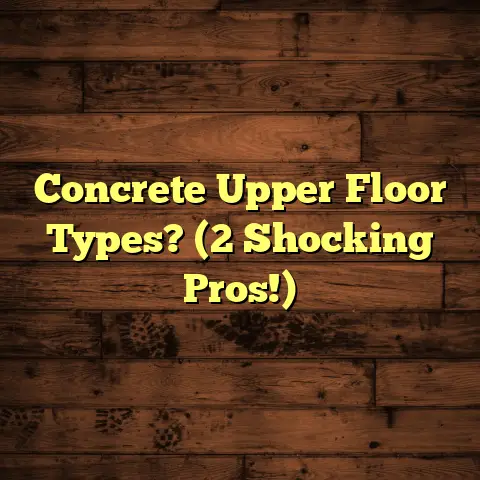Wood Floor Layout? (6 Layout Mistakes Costly!)
I’m here to drop some serious knowledge on you today.
We’re diving deep into the world of wood floor layouts.
Trust me, as a flooring contractor with years under my belt, I’ve seen it all.
And let me tell you, a poorly planned wood floor layout can be a disaster.
It’s not just about aesthetics, folks.
We’re talking about potential financial nightmares and the soul-crushing frustration of having to rip everything up and start over.
So, before you even think about picking up a single plank, listen up.
I’m going to walk you through six common layout mistakes that can cost you big time.
Let’s get started!
The Importance of Proper Wood Floor Layout
Okay, so why is layout so darn important anyway?
Well, think of your wood floor as the foundation of your room’s entire aesthetic.
It’s the canvas upon which you’ll paint your design masterpiece.
The layout dictates the flow of the room, influences how light reflects, and even impacts the perceived size of the space.
A well-executed layout can make a room feel larger, more inviting, and more cohesive.
Conversely, a bad layout can make a room feel cramped, disjointed, and just plain wrong.
According to the National Association of Realtors, homes with hardwood floors tend to sell for 2.5% more than homes without them.
But that premium only applies if the floors look amazing!
A poorly laid floor can actually decrease your home’s value.
Trust me, I’ve seen it happen.
Think of it this way: you wouldn’t build a house without a blueprint, would you?
The same principle applies to wood flooring.
Understanding layout is absolutely critical before you even purchase your materials.
It’s the key to unlocking the full potential of your wood floors and creating a space you’ll love for years to come.
Mistake #1 – Ignoring the Room’s Shape and Size
Alright, let’s dive into the first big mistake: ignoring the room’s shape and size.
This is a classic blunder, and it’s surprisingly common.
You see, different room shapes demand different layout approaches.
A square room, for example, offers more flexibility than a long, narrow rectangular room.
In a square room, you can often get away with running the planks in either direction.
However, in a rectangular room, the direction of the planks becomes much more critical.
Why?
Because running the planks along the shorter dimension of the room can make it feel even narrower and more cramped.
It’s like putting horizontal stripes on someone – it visually widens them.
The same principle applies to rooms with unusual angles or alcoves.
You need to carefully consider how the layout will interact with these architectural features.
I’ve seen countless homeowners choose a layout style they saw in a magazine without considering their own room’s dimensions.
The result?
A disjointed, awkward-looking floor that completely clashes with the space.
Don’t be that person!
Before you even start planning your layout, take the time to carefully measure your room and analyze its shape.
Consider any unique features or challenges that might influence your decision.
Mistake #2 – Wrong Direction of Planks
This is a biggie, folks.
The direction in which you lay your planks can have a dramatic impact on the visual appeal of your room.
It can affect how light reflects off the floor, how spacious the room feels, and even the overall mood of the space.
The most common mistake I see is laying the planks in the wrong direction relative to the room’s main source of natural light.
Ideally, you want to run the planks parallel to the longest wall with the most windows.
This allows the light to flow along the length of the planks, accentuating their natural beauty and creating a sense of depth.
Running the planks perpendicular to the light source, on the other hand, can create harsh shadows and make the floor look choppy and uneven.
Another common mistake is laying the planks in the wrong direction relative to the room’s entryway.
You want to create a sense of welcome and flow as people enter the room.
Running the planks towards the entryway can draw the eye into the space and make it feel more inviting.
Running them away from the entryway can create a sense of resistance and make the room feel smaller.
Here’s a simple rule of thumb: when in doubt, run the planks in the direction of the longest wall.
This will usually create the most visually appealing and spacious-feeling result.
Mistake #3 – Overlooking Expansion Gaps
Okay, let’s talk about something that might not be as visually exciting as plank direction, but it’s just as important: expansion gaps.
What are expansion gaps, you ask?
They’re small spaces (typically around 1/4 to 3/8 of an inch) that you leave around the perimeter of the room when installing a wood floor.
These gaps allow the wood to expand and contract with changes in temperature and humidity.
Without them, your floor is essentially trapped, and it will inevitably buckle, warp, or even crack as the wood expands.
I’ve seen countless flooring failures caused by inadequate expansion gaps.
It’s a heartbreaking sight, especially when the homeowner has invested a lot of time and money into their new floors.
The worst part is that it’s such an easily avoidable mistake!
All you need to do is use spacers during installation to ensure that you’re leaving the correct amount of space around the edges of the room.
These spacers are inexpensive and readily available at any home improvement store.
Don’t skip this step!
It’s absolutely crucial for the long-term health and stability of your wood floors.
I once had a client who insisted on skipping the expansion gaps because he didn’t like the way they looked.
I warned him repeatedly about the potential consequences, but he wouldn’t listen.
A few months later, I got a call from him.
His floors were buckling and warping all over the place.
He had to rip everything up and start over, and it cost him thousands of dollars.
Learn from his mistake.
Mistake #4 – Failing to Consider Lighting
Lighting, both natural and artificial, plays a huge role in how your wood floors look and feel.
And yet, it’s often overlooked during the layout planning process.
This is a big mistake!
The way light interacts with your floors can dramatically affect their color, texture, and overall appearance.
For example, dark wood floors tend to absorb more light, making a room feel cozier and more intimate.
Light wood floors, on the other hand, reflect more light, making a room feel brighter and more spacious.
The direction of the light is also important.
As I mentioned earlier, running your planks parallel to the main source of natural light can accentuate their natural beauty and create a sense of depth.
But what about artificial lighting?
Well, different types of light bulbs can cast different hues and tones on your floors.
For example, incandescent bulbs tend to cast a warm, yellow light, while LED bulbs tend to cast a cooler, bluer light.
Before you choose your flooring and plan your layout, take the time to assess the lighting conditions in your space.
Consider the amount of natural light you receive, the direction from which it comes, and the types of artificial lighting you plan to use.
Bring samples of your flooring into the room and observe how they look under different lighting conditions.
This will help you choose the right flooring and layout to create the perfect ambiance for your space.
Mistake #5 – Neglecting Underlayment
Underlayment is the unsung hero of wood flooring.
It’s the layer of material that sits between your subfloor and your finished wood floor.
And while it might not be the most glamorous part of the installation process, it’s absolutely essential.
Underlayment provides a number of important benefits, including sound insulation, moisture protection, and cushioning.
It can also help to level out minor imperfections in your subfloor, creating a smoother and more stable surface for your wood floors.
Despite its importance, underlayment is often neglected or installed improperly.
This is a huge mistake!
Improper underlayment can lead to a host of problems, including squeaky floors, moisture damage, and premature wear and tear.
There are many different types of underlayment available, each with its own unique properties and benefits.
Some are designed for sound insulation, while others are designed for moisture protection.
The best type of underlayment for your project will depend on a number of factors, including the type of wood flooring you’re using, the condition of your subfloor, and your specific needs and priorities.
Before you install your wood floors, take the time to research different types of underlayment and choose the one that’s right for you.
And be sure to follow the manufacturer’s instructions carefully during installation.
Mistake #6 – Poor Transitions Between Rooms
Finally, let’s talk about transitions.
Transitions are the points where your wood floor meets another type of flooring, such as tile, carpet, or laminate.
They’re also the points where your wood floor transitions from one room to another.
Poorly executed transitions can disrupt the flow of your home, create tripping hazards, and detract from the overall aesthetic of your space.
The key to creating seamless transitions is to use transition strips.
These are specially designed pieces of molding that bridge the gap between two different flooring types.
Transition strips come in a variety of materials, colors, and styles to match your flooring.
They’re easy to install and can make a huge difference in the look and feel of your home.
When choosing transition strips, be sure to consider the height difference between the two flooring types.
You’ll want to choose a transition strip that is tall enough to cover the gap and create a smooth, even surface.
Also, be sure to choose a transition strip that is durable and can withstand heavy foot traffic.
Poor transitions are like speed bumps in your home’s design flow.
They interrupt the visual harmony and can even be a safety hazard.
Take the time to plan your transitions carefully and use high-quality transition strips to create a seamless and beautiful look.
Conclusion
So, there you have it: six costly wood floor layout mistakes to avoid.
By taking the time to plan your layout carefully and avoid these common pitfalls, you can ensure that your wood floors look amazing and last for years to come.
Remember, a well-executed wood floor layout can enhance the beauty, value, and functionality of your home.
It’s an investment that will pay off in the long run.
So, don’t rush the process.
Take your time, do your research, and consult with a professional if you need help.
Your floors (and your wallet) will thank you for it!
Happy flooring!





